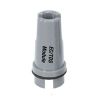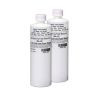Extech ExStik II Conductivity Meter
Features
- Units of measure include μS/cm, mS/cm, ppm, ppt, mg/L, and g/L
- Automatic temperature compensation of 2% per °C
- Self calibration of electronics on power up
- Expedited repair and warranty service
- Lifetime technical support
- More
Overview
The Extech ExStick Conductivity/TDS/Salinity Meter features a high-accuracy multi-range sensor that measures four parameters: conductivity, TDS, salinity, and temperature. The autoranging meter offers 3 ranges of measurements from tap water to wastewater and any aqueous solution. The units of measure include μS/cm, mS/cm, ppm, ppt, mg/L, and g/L.
Data Potential
Adjustable conductivity to TDS ratio is from 0.4 to 1.0 to conveniently calculate the TDS value. The large 2000-count digital display simultaneously displays conductivity, TDS, salinity, and temperature, and uses an analog bar graph to indicate sample trends. The internal memory stores up to 25 labeled readings for easy recall. The conductivity module is easy to replace, and the self-calibration function activates when the meter powers on. Other meter functions include data hold, power off, and low battery indication.
In The News
What is Conductivity?
UPDATE : Fondriest Environmental is offering their expertise in conductivity through their new online knowledge base. This resource provides an updated and comprehensive look at conductivity and why it is important to water quality. To learn more, check out: Conductivity, Salinity and TDS. Salinity and conductivity measure the water's ability to conduct electricity, which provides a measure of what is dissolved in water. In the SWMP data, a higher conductivity value indicates that there are more chemicals dissolved in the water. Conductivity measures the water's ability to conduct electricity. It is the opposite of resistance. Pure, distilled water is a poor conductor of electricity.
Read MoreSupplying Seattle’s Drinking Water: Using Data Buoys to Monitor the Cedar River Municipal Watershed
Providing clean, safe, and reliable drinking water for the 1.6 million people in the greater Seattle area is a top priority for Seattle Public Utilities (SPU). With limited water supplies, SPU dedicates considerable resources to maintain its watersheds and mountain reservoirs. About 70 percent of Seattle Water comes from the Cedar River Municipal Watershed , and the other 30 percent comes from the South Fork Tolt River Watershed . [caption id="attachment_39574" align="alignnone" width="940"] Data buoy in Chester Morse Lake . (Credit: Kevin Johnson / Seattle Public Utilities) [/caption] Jamie Thompson, a fisheries biologist at SPU, monitors aquatic ecosystems centered on fish listed under the U.S. Endangered Species Act (ESA).
Read MoreData-Driven Advocacy on the Lower Deschutes River
Like many freshwater environments, the Deschutes River in Oregon is under pressure from development, pollution, and climate change. Many rivers, streams and lakes in the Deschutes Basin do not meet Oregon water quality standards –where state water quality monitoring assesses levels of bacteria, pH, dissolved oxygen, temperature, and fine sediment. Hannah Camel is the Water Quality Coordinator for the Deschutes River Alliance (DRA), a non-profit organization that focuses on the health of the lower 100 miles of the Deschutes River–the area most affected by human intervention. As a data-driven organization, the DRA has benefited from the installation of two NexSens X2 data loggers.
Read More











